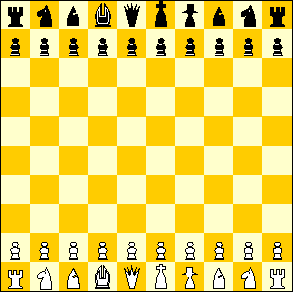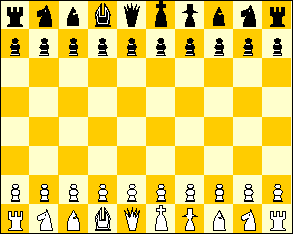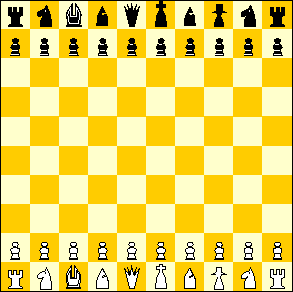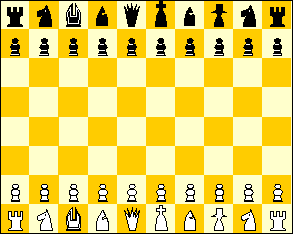Capablanca's chess

The great chess master and world champion Jose Raul Capablanca (1888-1942) proposed this chess variant, after he had gained the world champion title from Lasker. A description of this game can be found in the books of Gollon and Pritchard.
See also:
- Description of a program playing Capablanca Chess.
- The program.
- This game can be played via email on Richard's Play-By-eMail Server.
- A very short Capablanca chess game.
There are actually a few different variants, as Capablanca experimented with the rules before setting on a final design. Capablanca varied with some related, but different setups, until settling on a specific form. The setups differed in the location of the new pieces,
Rules
Each of the variants is played on either a ten by eight board, or a ten by ten board. Each player has a king, a queen, a chancellor (sometimes called differently), an archbishop (sometimes called differently), two rooks, two knights, two bishops, and ten pawns.
The first version was played on a ten by ten board, with the new pieces between a bishop and king or queen.
 White:
White:
King f1; Queen e1; Archbishop d1; Chancellor g1; Rook a1, j1; Knight
b1, i1; Bishop c1, h1; Pawn a2, b2, c2, d2, e2, f2, g2, h2, i2, j2.
Black:
King f10; Queen e10; Archbishop d10; Chancellor g10; Rook a10, j10; Knight
b10, i10; Bishop c10, h10; Pawn a9, b9, c9, d9, e9, f9, g9, h9, i9, j9.
It is not clear whether the first change made was to a board with only
eight rows, or to a setup with the new pieces between knight and bishop.
Thus, one of the following two setups was an intermediate form.
 White:
White:
King f1; Queen e1; Archbishop d1; Chancellor g1; Rook a1, j1; Knight
b1, i1; Bishop c1, h1; Pawn a2, b2, c2, d2, e2, f2, g2, h2, i2, j2.
Black:
King f8; Queen e8; Archbishop d8; Chancellor g8; Rook a8, j8; Knight b8,
i8; Bishop c8, h8; Pawn a7, b7, c7, d7, e7, f7, g7, h7, i7, j7.
The setup above was used by Bill Angel in his program that plays Capablanca Chess. At one point Capablanca also changed the names of his pieces. The older names are Marshall for Chancellor, and Chancellor for Archbishop. These older names are also used in Angel's program.
 White:
White:
King f1; Queen e1; Archbishop c1; Chancellor h1; Rook a1, j1; Knight
b1, i1; Bishop d1, g1; Pawn a2, b2, c2, d2, e2, f2, g2, h2, i2, j2.
Black:
King f10; Queen e10; Archbishop c10; Chancellor h10; Rook a10, j10; Knight
b10, i10; Bishop d10, g10; Pawn a9, b9, c9, d9, e9, f9, g9, h9, i9, j9.
The final version upon which Capablanca settled is the following. Edward Lasker writes in his book The Adventure of Chess from 1950 that he has played many games with Capablanca on the 10 by 10 board, and the 10 by 8 board, which was the final design, with the setup given below.
 White:
White:
King f1; Queen e1; Archbishop c1; Chancellor h1; Rook a1, j1; Knight
b1, i1; Bishop d1, g1; Pawn a2, b2, c2, d2, e2, f2, g2, h2, i2, j2.
Black:
King f8; Queen e8; Archbishop c8; Chancellor h8; Rook a8, j8; Knight b8,
i8; Bishop d8, g8; Pawn a7, b7, c7, d7, e7, f7, g7, h7, i7, j7.
Moves and rules
Most rules are as in orthodox chess. We mention the differences only:
The chancellor has the combined moves of rook and knight, i.e., each move the chancellor may move either as a rook, or as a knight. (This is similar to the queen, who has the combined moves of rook and bishop.)
The archbishop has the combined moves of bishop and knight.
When a player castles, the king always moves three squares towards the rook.
Pawns can promote to queen, archbishop, chancellor, rook, knight, or bishop, to the owning players choice.
Pawns on the ten by ten board
In the versions on the ten by ten board, pawns may also move initially three squares. En-passant taking of pawns is modified accordingly: a pawn can be taken en-passant when it moves more than one square and `passes' or `moves alongside' an enemy pawn.
Equipment
You can use some kind of Chess variant construction set that will let you make boards of different shapes and sizes. You might use a Rook and a Bishop from a larger Chess set to represent the Chancellor and Archbishop, or you could buy specially made pieces.
Bill Angel ((email removed contact us for address) s.cais.com) drew my attention to this variant. He has made a modification of the gnuchess program, that plays Capablanca's chess.
The picture of Capablanca is from Palle Mathiasen's World Chess Champions site. David Paulowich gave additional information on Capablanca's chess, which allowed me to modify the description of this game to give a more accurate and complete overview, and correct some errors. Written by Hans Bodlaender; additions by Hans Bodlaender and David Howe..
WWW page created: November 20, 1995. Last modified: November 28, 2000.